The Snake River Chinook Story
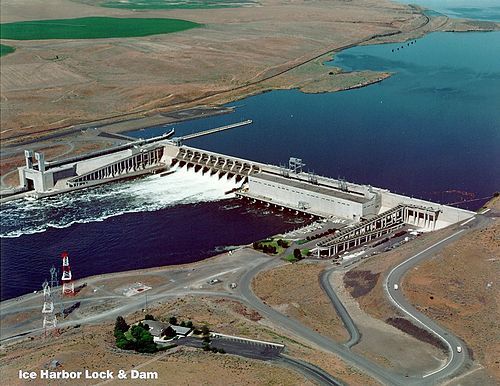
There’s been quite a lot of interest lately in removing the lower Snake River dams, and people have asserted that a) removing them would cause a huge increase in Snake River chinook and b) the increase could help to save endangered Southern Resident orcas. Both of those conclusions rest on shaky ground.
Let’s look at the first one, using the latest draft of an official report on Columbia River salmon called the Comparative Survival Study. First, some terminology: smolts are (loosely speaking) baby salmon; they swim downriver through the dams (or are barged around them), out into the ocean, where they feed and grow, until they return as adults. We can count smolts as they begin their journey down-river, and we can estimate how many of them make it back to the river as adults (the exact details are very complicated—let’s just assume for now that they have been calculated correctly). This ratio of returning adults to smolts is called the Smolt-to-Adult Return rate (SAR), and it captures the portion of the life cycle that most influences population growth.
At first glance, it seems obvious that the Snake River dams destroyed the Snake River chinook population, because the smolt-to-adult ratios crashed as the dams were built (the red markings are mine):
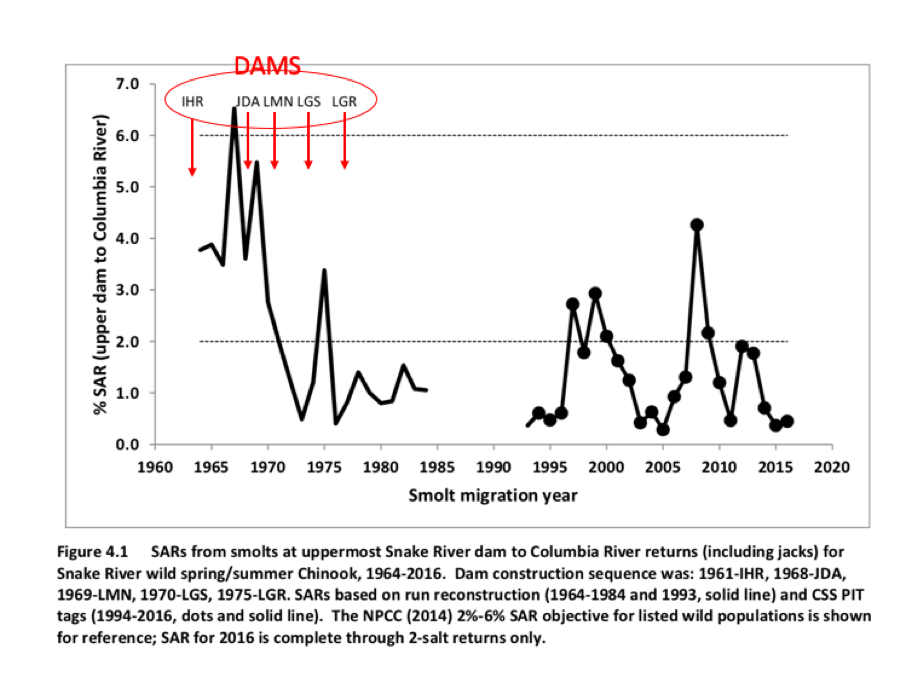
However, look at the marine survival rates during the same period:
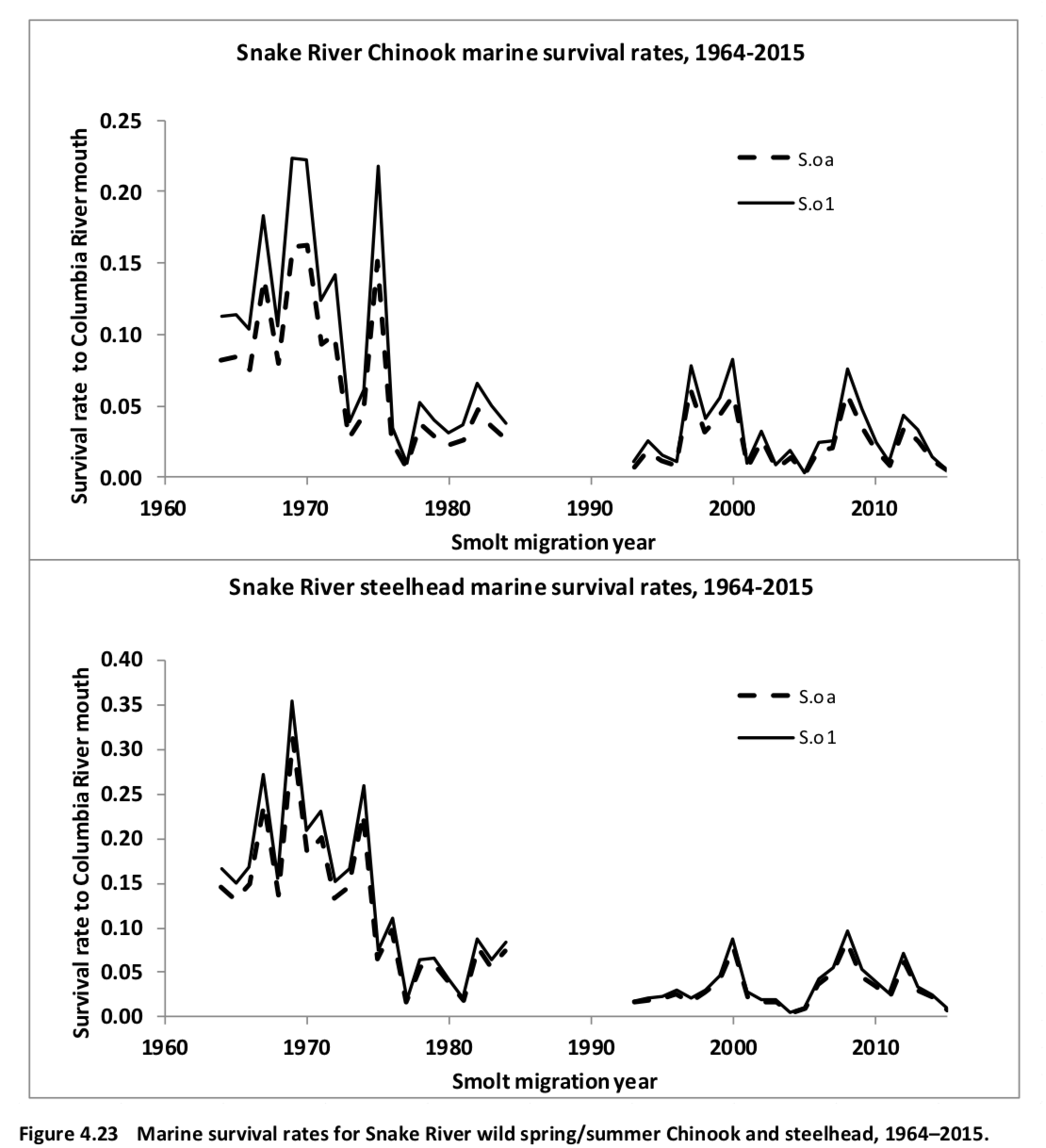
The report text says that the geometric mean survival rate has dropped from 13.4% in the early 1960s to 2.3% in 1994-2015 for Snake River wild spring/summer Chinook; and the mean survival rate for wild steelhead has dropped from 19.9% to 3% during the same timeframe (a geometric mean is just an average of numbers that are normally multiplied, rather than added). Those are horrendous drops in survival.
So, it looks like dams and the ocean were both bad for Snake River chinook. Which of the two matters more?
The survival rate of smolts swimming down the entire Columbia river is roughly 50%. The latest smolt-to-adult Snake River chinook return rate was less than one percent (0.8%, to be exact). You may think, “Aha! The dams take 50% of the fish, but the ocean only takes 49%!” However, survival rates are multiplicative (i.e., exponential), like interest rates. If 50% of the fish had survived the dams and 50% of those had survived the ocean, the smolt-to-adult return rate would be 25%. If you do the multiplication, you realize that overall, survival of Columbia River salmon during their ocean life phase is much lower than survival during their in-river phase, despite all of the dams. Of course, the fish spend much longer at sea than in the river, and it is thought that the highest mortality per unit time occurs while the smolts are in the river and in the transition to their first month or two at sea; however, exactly how salmon survival rates vary through time is not known. (If the time periods bother you, then imagine only two periods: river and ocean. In the first period (in-river), the population of smolts drops from 100% to 50%, which is a 50% survival rate; in the second period (ocean) it drops from 50% to 0.8%, a 1.6% survival rate).
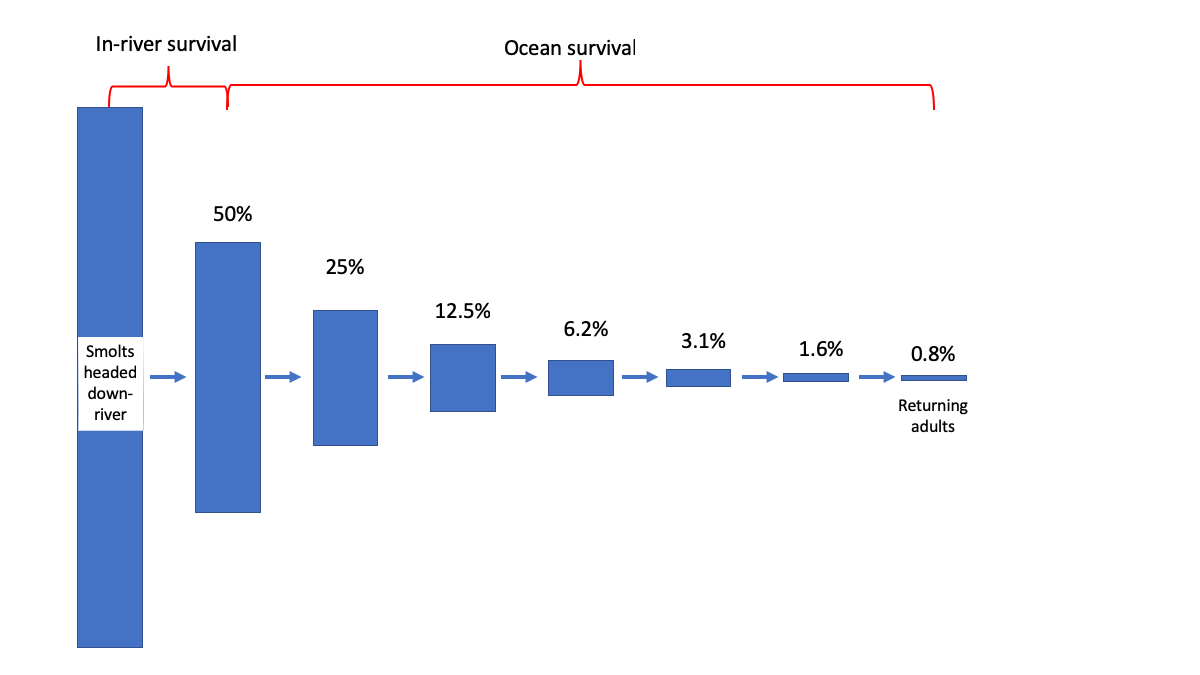
The impact of a hypothetical constant 50% mortality rate on a salmon population, over 7 time periods of undefined length. Note that it takes 1 period of 50% survival in the river plus 6 periods in the ocean to match the observed rates (50% in-river; 0.8% returning adults).
Could dams just be weakening the fish?
It may occur to you that perhaps what is really happening is that the dams are weakening (but not quite killing) smolts, which then die in the ocean. That idea has been named the “delayed mortality hypothesis.” If it was true, then smolts that pass through a lot of dams would die in the ocean at a higher rate than smolts that don’t pass any dams. A team tested that idea using acoustic tags that could track fish in the ocean as they migrated north along the continental shelf, and found no support for it: survival rates were the same in the two groups. They also found, rather counterintuitively, that survival rates per mile are about the same in the Columbia as in un-dammed rivers. This does not mean that dams don’t kill fish—they do—but it suggests that their impact isn’t as great as one would assume. Essentially, fish die in the river from a multitude of causes, of which dams are just one.
All of this sticks in the craw of many people, myself included, because it seems contrary to common sense. And it’s not exactly a good reason to preserve the dams. If ocean survival ever improves, we want salmon to have the best chance possible, and removing dams would help them. But it does warn us that the impact of removing dams might not be nearly as great as we would hope, so long as the main problem remains poor survival in the ocean.
A group of salmon experts called the Independent Science Advisory Board (ISAB) just reviewed the latest Comparative Survival Study (CSS) for Columbia River salmon and steelhead. Their opinions are about as close to an “official” point of view as one can get. They came to the same conclusion:
“One thing the CSS report has consistently reported the last few years is that many anadromous fish species fail to meet the 2 to 4 percent smolt to adult survival goal called for in the Northwest Power and Conservation Council’s Fish and Wildlife Program. Species that aren’t meeting the goal are Snake River wild spring/summer chinook, Snake wild steelhead populations, as well as the hatchery fish of these species, and Snake River sockeye salmon. Most wild and hatchery steelhead, chinook and sockeye in the middle and upper Columbia River and tributaries also are not meeting the Council’s goal.”
In other words, smolt-to-adult survival is indeed generally very low and has been for some time. In their summary, the ISAB wrote:
“The ISAB is concerned that the overall pattern of low SARs of Upper Columbia and Snake River spring/summer Chinook and steelhead in 2015-2016, as shown In Chapter 4, is likely to continue, particularly in light of the apparently poor early ocean survival of juvenile salmon in 2017 and unprecedented ocean conditions in 2018 in the Northern California Current and Gulf of Alaska.”
In other words, this highly-respected bunch of experts also think that ocean conditions are driving the survival patterns, especially since we seem to be entering another year of "the blob," (a large area of warmer-than-usual water in the Gulf of Alaska that decimated fish and seabird populations last time it occurred).
The CSS report also found that reproduction--the other factor that determines population growth--was correlated with smolt-to-adult return rates, and there was significantly lower productivity in bad years (to be precise: fewer adult recruits to the spawning ground per adult spawner in brood years with low SARs). In fact, they found that smolt-to-adult rates less than 1% were associated with major declines in Snake River chinook, and that they needed a SAR of at least 2% for the population to stabilize or grow. There have only been two years since the year 2000 where the SAR was above 2% for Snake River chinook. Finally, a new paper by David Welch's team found that steep declines in Chinook and steelhead marine survival span the entire Pacific coast of North America, excluding California. The outlook seems grim indeed.
Would removing the lower Snake River dams help Southern Resident orcas?
It’s been said that a big increase in Snake River chinook would help the endangered Southern Resident orcas. The idea is appealing because some members of the orca pod apparently starved to death recently, and chinook are known to be an important component of the orcas' diet. However, Southern Resident orcas have other problems such as suffering from appallingly high levels of chemical pollution that bio-accumulate up the food chain, and even if chinook in general are important to the Southern Resident orcas, it’s not clear that Snake River chinook in particular matter much to them. A recent blog post by a local scientist, Joshua Murauskas, made that point visually, and I reproduce his image here. I see no evidence of a correlation, even allowing for reproductive delays, etc. That doesn't mean that Southern Resident orcas don't eat Snake River chinook on occasion, but it does suggest that their population isn't dependent on them.
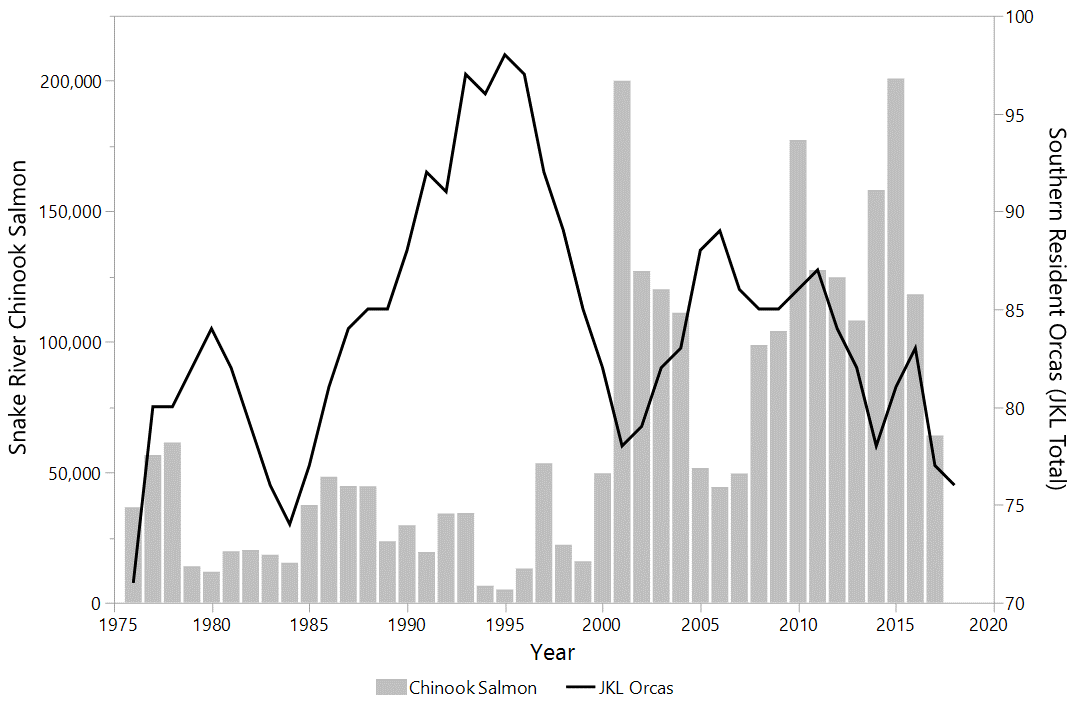
The bottom line
Most people respond to these findings by saying: “We can’t change what’s happening in the ocean, so let’s do what we can on land.”
I think that response is a bit short-sighted. First, pretending that the main problem is on land when it is actually in the ocean has an obvious cost, which is that it reduces our concern about the ocean. We could spend a lot of time and money removing dams, only to find that that it doesn’t bring salmon or orcas back, and that would undermine public support for similar interventions. A group called Save Our Wild Salmon discuss the tradeoffs for transportation, green energy and irrigation, and have made a good case for removing the 4 lowest Snake River dams, but we ought to be honest about the likely outcome for salmon.
Second, we should not assume that “we can’t do anything about the ocean” until we know what is really happening. Why are orcas and salmon dying out there? There is almost no research funding available to find out. Of course, it’s an extremely difficult challenge to understand what is happening at sea, but we don’t know what we’ll find until we look, and it may be that we could do something about the problems. For example, if orcas or salmon were being killed primarily by chemical pollution or microplastics, those would be problems that we could attack. It’s even conceivable that we could do something with genetic manipulation or selective breeding if some salmon stocks were migrating to areas with higher mortality than others. If global warming or ocean acidification are the real culprits, then salmon are screwed, but at least they will become a powerful part of the public narrative about the need to stop global warming, and that won’t happen if their problems are all blamed on dams.
The conclusion, in my view: It makes sense to consider removing dams, but we should be honest about the tradeoffs and the likely outcomes, and the public should be made aware that low ocean survival is a very serious problem for salmon. In the meantime, government ought to fund a lot more ocean research, because that’s where the most serious problems are.